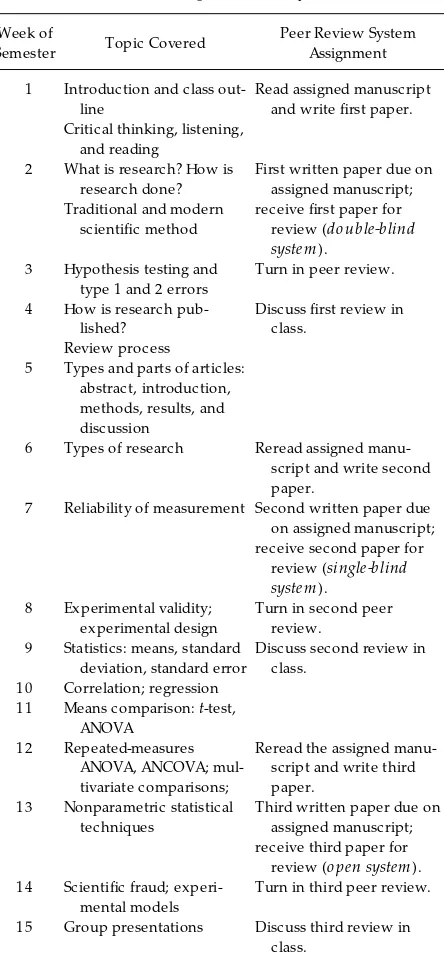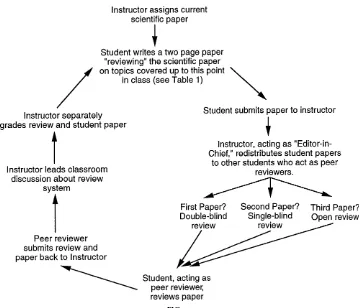A DIFFERENT METHOD OF TEACHING
PEER REVIEW SY STEMS
J. Timothy Lightfoot
Depa rtm ent of Hea lth Prom otion a nd Kinesiology, University of North Ca rolina -Cha rlotte, Cha rlotte, North Ca rolina 28233
S
tudents often have difficulty grasping the advantages and disadvantages of the various peer review systems used in scientific publishing. In the described exercise, students are assigned a current study and then write three two-page critiques of the article. The three critiques occur at different times in the semester, and thus the students have differing knowledge bases. The critiques are then assigned to other students for peer review using the double-blind, single-blind, or open review systems. After the submission of each peer review, the class discusses the various advantages and disadvantages of each peer review system. In addition to experiencing peer review, in using this method students also gain an appreciation for the difficulty of judging the merit of a peer’s work.AM. J. PHYSIOL. 274 (ADV. PHYSIOL. EDUC. 19): S57–S61, 1998.
Key words:experiential method; reviewing
Many physiology training curricula include a class on reviewing scientific literature and research design. Upon accepting a teaching position at another univer-sity, I was given the task of developing such a course. In this course, there was a mix of undergraduate and graduate students, all with an elementary statistics background. Besides covering basic research design and statistics, the course was supposed to educate the students on how to review and critique scientific literature and how this type of critique fits into the normal publication process. The first two times I taught the course, I found that the students had trouble relating to the abstract advantages/disadvan-tages of the different peer review systems. Difficulties in understanding the purpose of peer review (1) and the effects of various blinding systems (2) are also common among scientists. Anecdotally, it appeared that the difficulty in obtaining the core concepts of peer reviewing was often caused by the fact that most
students at this early point in their education had never had to review and judge their peers’ work. Therefore, over the past four years I have used a participatory approach that actually allows each stu-dent to be an author and a reviewer in each of the three major types of peer review system. The objec-tives in developing this approach were to have stu-dents be able to
1) Explain the disadvantages and advantages of peer review
2) Describe the disadvantages and advantages of different forms of peer review
3) Assess the time and effort that is involved in thorough review
5) Demonstrate critical thinking skills
In the development of this participatory exercise, the various peer review systems were defined as follows. In the double-blind system, both reviewers and au-thors are anonymous. The editor is the only person who knows the identity of the parties involved in the review. In thesingle-blind system, the identity of the reviewer is unknown to the author but the reviewer knows the identity of the author. In theopen system, the author knows the identity of the reviewer and the reviewer knows the identity of the author.
METHODS
On the first day of class, an article chosen from a recent scientific journal in our discipline (usually from Journa l of Applied Physiology or Medicine a nd Science in Sports a nd Exercise) was distributed to the students. The article selected for use exhibited a standard format and was on a topic that was currently the subject of much discussion and writing within the discipline. These criteria allowed the students to work with an article that did not deviate from normal journal format (e.g., introduction, methods, results, discussion) but yet was an article on which there were numerous resources and background materials for the students. The assigned article was the basis of three two-page papers that each student wrote at three distinct time points in the class (Table 1). The students were instructed to examine the topic article using critical thinking skills and to report on whether the topic article was a valid scientific article, on the basis of their current level of knowledge at the time. Because the students had to write three papers at different time points in the class (Table 1), they had different knowledge bases depending on what was covered in the class at the time they wrote each paper. Before each paper was written it was emphasized that the paper should be a critical analysis of the topic article, with the students relying on reference material from the same authors and other researchers in the same area. Further instruction as to what should be contained in the students’ critical examination was not given, partly to encourage the students to use a creative approach to determining whether the topic article was of valid scientific content.
When the students turned in their first papers (Table 1), the instructor removed the cover sheets containing the name of the student author and assigned each paper a code number (Fig. 1). Each paper was then randomly assigned to a reviewer who also was identi-fied by a code number. These reviewers were actually
TABLE 1
Schedule of peer r eview cycle
Week of
Semester Topic Covered
Peer Review System Assignment 1 Introduction and class
out-line
Critical thinking, listening, and reading
Read assigned manuscript and write first paper. 2 What is research? How is
research done? Traditional and modern
scientific method
First written paper due on assigned manuscript; receive first paper for
review (double-blind system).
3 Hypothesis testing and type 1 and 2 errors
Turn in peer review. 4 How is research
pub-lished? Review process
Discuss first review in class.
5 Types and parts of articles: abstract, introduction, methods, results, and discussion
6 Types of research Reread assigned manu-script and write second paper.
7 Reliability of measurement Second written paper due on assigned manuscript; receive second paper for
review (single-blind system).
8 Experimental validity; experimental design
Turn in second peer review.
9 Statistics: means, standard deviation, standard error
Discuss second review in class.
10 Correlation; regression 11 Means comparison:t-test,
ANOVA 12 Repeated-measures
ANOVA, ANCOVA; mul-tivariate comparisons;
Reread the assigned manu-script and write third paper.
13 Nonparametric statistical techniques
Third written paper due on assigned manuscript; receive third paper for
review (open system). 14 Scientific fraud;
experi-mental models
Turn in third peer review. 15 Group presentations Discuss third review in
students in the same class who acted as the ‘‘peer reviewers’’ of the peer review systems. Therefore, each student in the class acted not only as an author of a paper (i.e., paper concerning the assigned manu-script), but also as a peer reviewer (i.e., review of another student author’s paper).
Each peer reviewer was given the paper along with a standardized review sheet developed by the instructor that specified that the review should deal with the following areas
1) grammar and spelling
2) content
3) critical thinking
4) overall evaluation of paper (denoted by assignment of a letter grade)
The peer reviewers/students, before embarking upon their review, were reminded of the strict confidential-ity of the review process and the nonpersonal manner in which criticism should be given. The students were given one and a half weeks to complete the review, at which time they returned the papers and their re-views and comments back to the instructor. At this point, the instructor led a discussion regarding the merits of the review system that was used during this review. Each student received a grade on his or her written paper, and each student received a grade on his or her review. Although the written paper was graded on items similar to the items on which it was reviewed, each peer review was primarily graded for completeness and whether or not the student re-viewer detected the obvious errors in the written paper. This cycle of ‘‘written paper-peer review-discussion’’ (Fig. 1) was then accomplished with the single-blind and, finally, open review systems at later time points in the semester (Table 1).
FIG. 1.
Given this description, it would appear that this method of teaching the peer review system would increase the workload of the instructor. However, with the use of this method with undergraduates, the instructor workload has remained similar to that of past semesters. The maintenance of course workload can be attributed to the fact that in most of the initial peer reviews, the majority of grammatical and spelling errors were caught and this reduced the amount of time that the instructor spent in grading and catching these types of errors.
CLASS GROUND RULES NEEDED TO MAKE THE EXERCISE WORK
This type of exercise can be problematic, especially with students reviewing their peers’ work. However, there were several ‘‘class ground rules’’ that enhanced the students’ comfort with the exercise and com-pletely eliminated any type of problem during this process.
First, because most students were very hesitant to critically review a peer’s work, the double-blind system was experienced first. The double-blind sys-tem, with its inherent guarantee of anonymity on the part of both the author and reviewer, removed most of the hesitation toward a critical review of a peer’s work. In later surveys, the majority of students sur-veyed preferred the double-blind peer review exer-cise because of the two-way anonymity.
Second, many students were hesitant to critically review a peer’s work because of the fear of altering the peer’s grade and of suffering reprisals. To alleviate these concerns, the instructor heavily emphasized that the instructor also reviewed all papers and reviews for appropriate content. It was further empha-sized that because the instructor reviewed all papers, the peer review played no role in grade assignment and thus, ultimately, it was the instructor who was responsible for class grading. Additionally, after the first review had been completed, the instructor stressed the nonpersonal nature of peer review criticism and the nature in which the criticism should be received. This type of discussion and continued reinforcement throughout the semester allowed the consideration of the single-blind and open peer review systems in a nonharassing and encouraging environment. In an
early, anonymous survey of one of the classes that had gone through this exercise, none of the students reported receiving any verbal post hoc feedback from any other students in the class.
Third, there were always concerns regarding the confidentiality of the reviewed papers. The instructor talked at great length about the need for confidential-ity and warned the students of severe sanctions if the confidentiality of the review process was compro-mised. This topic was reinforced throughout the semester.
In four years of using these class ground rules with approximately 140 students, no issues or incidents arose regarding the confidentiality of the reviews, student reprisals, or antagonism caused by the critical nature of the review processes.
CONCLUSION
had forced them to work harder on their writing skills. Although these results are in every sense tentative, they do lend support to the value of using this experiential method in teaching about the peer re-view system. Although the majority of the students will not go on to publish work in scientific journals, the majority of the students will become ‘‘consumers’’ of scientific publication. Therefore, their experience with the peer review process that is in effect during scientific publication can help increase their apprecia-tion of published research and the process that produces scientific publications.
Address for reprint requests: J. T. Lightfoot, Dept. of Health Promotion and Kinesiology, UNC-Charlotte, 9201 University City Blvd, Charlotte, NC 28223.
Received 11 July 1997; accepted in final form 17 February 1998.
Refer ences
1. Horr obin, D. F.The philosophical basis of peer review and the suppression of innovation.JAMA263: 1438–1441, 1990. 2. McNutt, R. A., A. T. Evans, R. G. Fletcher, and S. W. Fletcher.

